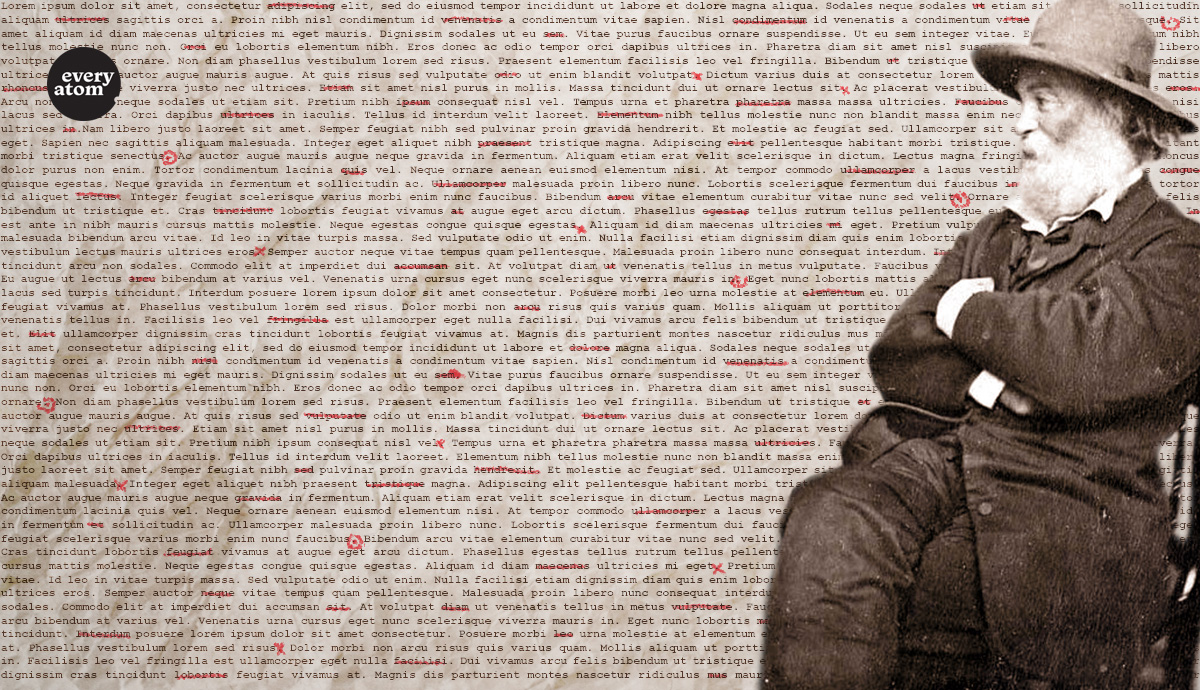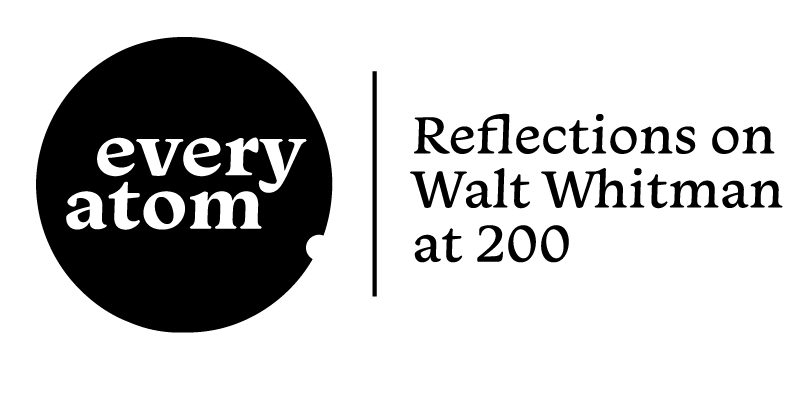Every Atom | No. 171
Introduction to Every Atom by project curator Brian Clements
Seldom do we think of Whitman subtracting. More often, we associate Whitman with adding on. How else to characterize the process of writing a volume of poetry that by his death would number more than four hundred pages in length, including pages-long catalogues of almost mere enumeration? But he had spent his early adult years as an editor, after all, and he left us plenty of proofs of his poetry with long slashes through whole sections, indicating a savage appetite for killing his darlings, or at least an enthusiasm for editorial surgery.
The above lines are from the first catalogue of Leaves of Grass. A quarter of the way into an expansive list of bodies in action, Whitman’s catalogue trips on itself at the mention of subtraction—the anatomist who must amputate the “malformed limbs.” In Whitman’s democratic epic, his catalogue of American persons substitutes for the traditional epic’s Catalogue of Ships, which enumerates military contingents. For Whitman, America’s greatest arms were its people. What a crucial pun, then, to include the amputation of arms within a list of America’s arms. That the amputation of the “malformed limbs” leads into the depiction
of a slave auction indicates slavery as a part of America’s anatomy that would need to be lopped off, like the auctioneer himself whom Whitman quietly excludes here from mention. The bloodless excision of the auctioneer from Whitman’s catalogue only suspended a violence that would revisit him as the war over slavery—which would also be the war of amputation—was at his doorstep.
Before the anatomist’s table, Whitman’s thirteen lines of catalogue steadily stream forth, and every body mentioned gets at least a whole line. After mention of the anatomist, however, the “quadroon girl” at auction shares a cramped line with the nodding drunkard, and ellipses proliferate. Whitman’s catalogue stutters at a critical point. As a poet of American democracy projecting to account for everyone, is he the jour printer who includes everything by mere translation from another medium? Is he just remediating matter? Is he the slave auctioneer who announces each body as part of a dehumanizing commerce? Or is he the anatomist who must amputate America’s malformed limbs?
Printer, anatomist, auctioneer, and cataloguer have in common that each occupationally relates parts to a whole. The printer sets letters that accrete to make prints and meaning. The anatomist removes appendages that harm the fuller body. The auctioneer commodifies bodies by anatomizing them. And the cataloguer enumerates the arms of a body politic.
Each occupation bears liability. The blurry-eyed jour printer is neither poet nor proper democrat, for lost in the minutiae of type, his vision cannot mediate between the single letter and the meaning-giving mass of the manuscript. He loses the individual for the crowd. The anatomist confers blood and suffering. The slave auctioneer conceals his violence for profit, presenting able bodies at auction that belie the abuses they have endured.
The profitability of counting bodies especially vexed Whitman, which is also why he gets mired here in quantities, associating the “quid of tobacco”—the American commodity that afforded and propagated colonial Virginia’s slave trade—with the “quadroon girl” commercialized by her quarter-Blackness, who is the first figure in the catalogue not to be granted the autonomy of her own line. Perhaps it would have been too polemically pat to give her three-fifths of one, according with the representation of enslaved persons per the U.S. Constitution. Whitman gives her exactly half a line, which she shares, 38 characters vs. 38 characters, with the drunkard, another figure essentialized by mixed or compromised blood but who gets to nod complacently in his privileged stupor while she is sold back into abuse.
Later, in the poem that would become “I Sing the Body Electric,” Whitman’s speaker makes to substitute for the slave auctioneer who finally bears mention but “does not know half his business”—a jab at slavery’s fractional accounting. “Gentlemen look on this curious
creature,” commands this new auctioneer. “Examine these limbs,” he continues. “They shall be stript that you may see them.” Both surgeon and auctioneer, Whitman anatomizes and announces the features and potentials of the Black body at auction, this time rejecting commodification—“Whatever the bids of the bidders they cannot be high enough for him”—and the blood fetishism that enabled it—“Within there runs his blood . . . . the same old blood . . the same red running blood.” The jour printer’s case full of letters invites poetic possibilities as numberless as the single body of the slave: “Of him countless immortal lives with countless embodiments and enjoyments.”
How does a poet dignify the body and relate it to the infinite in a time that commodifies the body and racializes the infinite? How does a poet account for the infinite within the fixity of a finite book? Whitman was shrewd with his accounting. And his scalpel.
Recommended
Nor’easter
Post-Op Appointment With My Father
Cedar Valley Youth Poet Laureate | Fall 2024 Workshop







